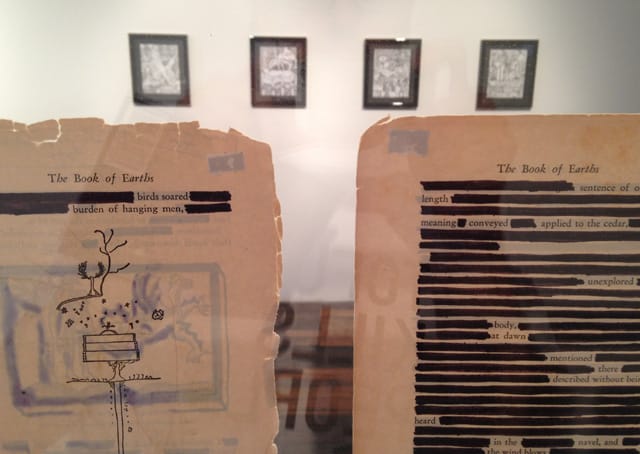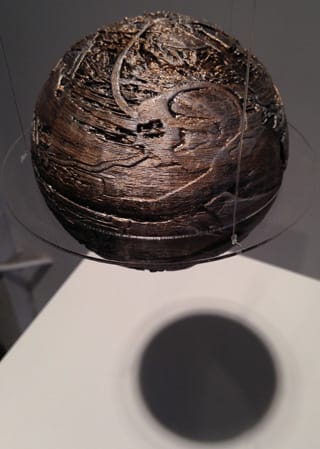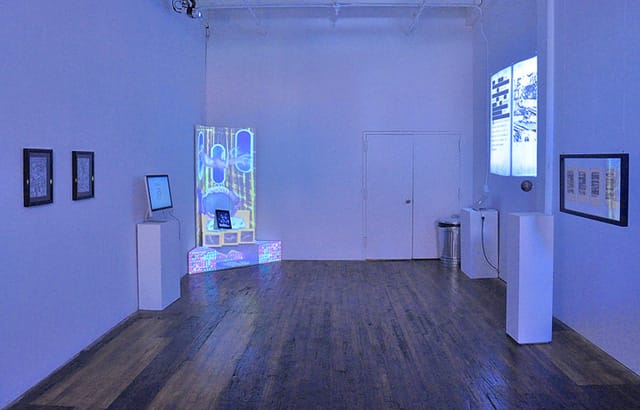The Shape of the Earth and Other Artistic Fictions
Art and poetry should be natural allies, but it's surprisingly rare to see both commingle as naturally as they did at a recent show at Transfer Gallery in East Williamsburg by Carla Gannis and Justin Petropoulos.

Art and poetry should be natural allies, but it’s surprisingly rare to see both commingle as naturally as they did at a recent show at Transfer Gallery in East Williamsburg, <legend> </legend>.

Featuring visual artist Carla Gannis and poet Justin Petropoulos, the show is the couple’s collaborative project of poems and drawings based on text redactions of Edna Kenton’s compendium of folklore on the shape of the Earth, The Book of Earths (1928).
The pair have conjured up a body of work — videos, drawings, sculptures, and installations — from Kenton’s compilation of bizarre ancient stories, including such fantastic tales as the Babylonian theory of a boat-shaped earth to the Aztec rendering of the earth as a cross.
Gannis and Petropoulos have allowed the weirdness of the legends to come through in their presentation. One 3D printed planet with a distinctly human ear amidst a swirl of abstract shapes perfectly encapsulates the juxtaposition of human and mechanical forms that occurs throughout the show — the resulting artistic hippogryphs seem to relish their mutant nature, writhing like flagellum in a petri dish.
The show is accompanied by a catalogue that features poetry by Petropoulos gleaned from The Book of Earths and accompanied by Gannis’s black and white drawings. “detail how a dictionary smells never // mind the membrane sleep in your own skin,” reads one stanza, while a drawing of human forms woven into a field of electronics sits across the page.

The poems themselves are vivid; it isn’t always clear that they were created with words culled from another text. Their rhythms and imagery seem to make for natural fodder for Gannis’s imagination: in the installations, a quilt of patterns and forms dance together like stained glass across a brocade. So many threads connect the works in this show that it feels difficult to talk about one work as distinct from the others, and this includes the catalogue, which simply feels like another limb of this corpus. The only thing that becomes fully obscured in the process is Kenton’s original book, which disappears into the background as a distant ancestor to this artistic progeny.
The show can be overwhelming, as words, images, projections, and surfaces are jammed with lines and patterns of all types. A more minimal display could have allowed for the meditation required to crack the surface of these dense works. Later, reading the book of poems and drawings at home, I easily saw glimpses of the poetic nature of the works that were not obvious at first in the display— it was something that I wished was more apparent in the gallery show itself.
Kenton’s book appears to offer the couple a springboard for their rich imaginations, but the final product pulls back from making their combined visions clear. Perhaps this is the type of show that seeps into your dreams, like an archetype or folkloric tale, and it will have a long life as it is transmitted online and broadcast through other channels. What <legend> </legend> reinforces is the increasingly apparent reality that gallery shows, even if they are a staple of the art world today, don’t always do justice to the full fruits of our visual imagination.

Carla Gannis and Justin Petropoulos’s <legend> </legend> concluded at Transfer Gallery (1030 Metropolitan Avenue, East Williamsburg, Brooklyn) on Sunday, September 28. A copy of the accompanying book is available jadedibisproductions.com.





